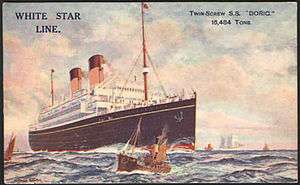RMS Regina
 SS Doric sistership of Regina which looked identical to her. | |
| History | |
|---|---|
| Name: | |
| Owner: |
|
| Port of registry: |
|
| Route: |
|
| Builder: | Harland & Wolff |
| Laid down: | 1917 |
| Launched: | 1917 |
| Completed: | 1919 |
| Maiden voyage: | March 1922 |
| In service: | 1917 |
| Out of service: | 1947 |
| Fate: | Scrapped |
| General characteristics | |
| Type: |
|
| Tonnage: | 16,313 GRT |
| Length: | 175.26 metres (575 ft 0 in) |
| Beam: | 21.03 metres (69 ft 0 in) |
| Depth: | 12.5 metres (41 ft 0 in) |
| Installed power: | Combination engine |
| Propulsion: | Triple Screw propeller |
| Speed: | 15 knots |
RMS Regina was a British Passenger ship and Troop transport during the first and second World War. She sailed under multiple companies until she was scrapped in 1947 after 30 years at sea.[1]
Construction
Regina was constructed in 1917 at the Harland & Wolff shipyard in Belfast, United Kingdom and named Regina. However it was the middle of World War I so it was decided that Regina would be launched earlier then expected. Therefore, her original commercial design wasn't completed which resulted in her only having one funnel instead of two. She would serve as a Troop transport until the end of the war before being completed for commercial use at the Harland & Wolff shipyard with a second funnel in 1919.
The ship was 175.26 metres (575 ft 0 in) long, with a beam of 21.03 metres (69 ft 0 in) and a depth of 12.5 metres (41 ft 0 in). The ship was assessed at 16,313 GRT. She had a Combination engine driving 3 screw propellers. She also had 2 sister ships SS Pittsburgh and SS Doric.[2]
Career/Owners
Regina returned to commercial service for Dominion Line after World War I in 1919. She made her maiden voyage for the White Star-Dominion Line joint service in March 1922, she sailed from Liverpool, United Kingdom to Halifax, Canada and to Portland, United States.
In 1925 Regina was transferred solely to White Star Line but kept her name as White Star refused to rename her. She was painted in White Star's colors and served 4 years for the company.[3]
In 1929 she was sold to the Belgian company Red Star Line and renamed Westernland, she was repainted again but this time in Red Star colors. From now on she sailed under the Red Star flag and sailed the Antwerp, Belgium - Southampton, United Kingdom - New York, United States route until 1935.
In 1935 Westernland/Regina was sold to Bernstein Red Star Line and later sold again to Holland America Line in 1939, she was still named Westernland at this point. When World War II broke out and German Troops invaded The netherlands in 1940, Westernland/Regina escaped to the United Kingdom and served as a home for the exiled Dutch Government at Falmouth, United Kingdom. Later in the war Westernland/Regina served again as a Troop transport and later as a Repair ship before finally serving as a Destroyer Depot ship until the end of the war.
Westernland/Regina was decommissioned in 1945 and returned to Cunard-White Star Line service. Cunard-White Star had plans to refit her but those plans were abandoned due to the ships old age. A final effort was done in 1946 to sell the ship and convert it into a Whale Deport ship, but that failed to. With nowhere to go, Westernland/Regina was sold for scrap and broken up in 1947 after an amazing career of 30 years and surviving both World Wars.[4]
References
- ↑ "White Star Line: the history of RMS Titanic owner". titanic2ship.com. 2013. Retrieved 4 February 2016.
- ↑ "White Star Line RMS Regina". titanicmemorials.co.uk. Retrieved 4 February 2016.
- ↑ "RMS Regina". theshipslist.com. 1997. Retrieved 4 February 2016.
- ↑ "SS Regina". titanic-whitestarships.com. 2007. Retrieved 4 February 2016.